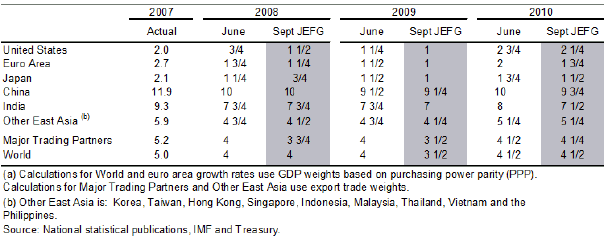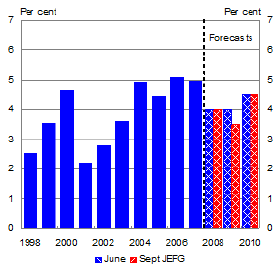Table 1: International GDP growth forecasts(a)

World outlook and risks
The world economy is facing its most difficult set of circumstances in many years as the credit crisis deepens and commodity prices remain at historically high levels. World growth is slowing markedly, following more than four years of rapid expansion, while inflation has risen to rates not seen in a decade, especially in emerging economies.
While growth in the global economy exceeded expectations during the early stages of 2008, it is now forecast to slow more severely through the second half of the year, with only a gradual recovery expected towards the end of 2009. Global GDP growth is expected to slow from 5 per cent in 2007 to 4 per cent and 3½ in 2008 and 2009 respectively, before reaccelerating toward 4½ per cent in 2010 (Table 1).
Recent weeks have seen a re-escalation of financial market turmoil as losses by major financial institutions have forced asset sales, placed downward pressure on asset prices and further impaired balance sheets. This chain of events has resulted in the failure and consolidation of a number of financial institutions in recent weeks.
The US Federal Reserve and other major central banks have acted to accommodate a sharp increase in demand for liquidity. In addition, US authorities have outlined a US$700 billion plan to remove troubled mortgage-related assets from the system and restore confidence to financial markets. However, despite concerted efforts, the crisis of confidence continues as concerns about the counterparty risk of large banks remains significantly elevated.
Chart 1: World GDP growth

Source: IMF and Treasury.
Financial institutions continue to hoard liquidity for precautionary reasons and concerns over the future solvency of their counterparties. Consistent with this, premiums charged on three month inter-bank loans relative to (essentially risk-free) overnight indexed swap rates have increased significantly over the past few weeks.
Moreover, the cost of insuring against bank default has also spiked, with credit default swap spreads indicating unusually high perceived risk of default amongst systemically important financial institutions.
These recent developments, if maintained, represent a significant downside risk to the global growth outlook. Advanced economies now face a period of growth well below trend, due to the ongoing strains in credit markets, high oil prices and weakening external demand.
In contrast, notwithstanding some moderation in export growth, economic momentum has remained robust in emerging economies, underpinned by strong domestic demand which has been largely unaffected by the financial markets turmoil to date.
The most immediate impact of recent financial market turbulence on emerging economies has been the sharp falls recorded in equity markets, most notably in Russia, which suspended stock exchange trading on 17 September amid the worst market falls since the country's 1998 financial collapse.
However, there is little apparent threat to these economies from tightening liquidity conditions or financial insolvency. Emerging market financial sectors remain underdeveloped, with credit intermediation largely occurring through domestic banks, which use significant domestic deposit bases. This is a predominantly closed loop, unexposed to more sophisticated financial products issued on global markets.
While there may be an indirect effect of the financial turmoil through confidence, the primary issue for emerging economies will be the slowing pace of growth in advanced economies, particularly for smaller emerging economies with a higher dependence on exports.
Signs of slowing growth have been most pronounced for those East Asian economies most closely linked to the global manufacturing cycle, including the NIE's1, the Philippines, Thailand, and to a lesser degree, India. Headwinds to activity have also intensified for Emerging Europe and Latin America, due to their exposure to euro area and US demand respectively.
Economies such as China and India have stronger underlying domestic growth momentum which is expected to continue over the forecast horizon, albeit, moderating to a slower pace.
Notwithstanding slowing activity in 2008, global headline inflation has risen to its highest rate since the late 1990s, propelled by the surge in key commodity prices. While in advanced economies headline inflation has risen sharply, emerging economies have experienced much stronger increases. This has been largely driven by significant increases in food prices, although recent falls in these prices will provide some respite.
Oil prices, having reached record highs in July, have fallen sharply to levels not seen since the start of 2008. This significant decline largely reflects a marked change in market sentiment due to weak growth outturns for a number of developed economies in the June quarter and concerns about the impacts of recent financial market turmoil on the global growth outlook. Sustained strong demand growth (driven by the acceleration of growth in emerging economies), a sluggish supply response and declining inventories all contributed to the earlier surge in prices.
Similarly, prices of major food commodities rose by almost 70 percent in the year to June 2008, but have moderated more recently. Looking ahead, commodity prices are likely to remain well elevated and highly sensitive to changes in demand and supply fundamentals, particularly as inventories remain at very low levels.
Country summaries
The US economic outlook for 2009 and 2010 has softened since June, despite a firmer outlook for growth in 2008. Given an earlier-than-expected boost from the fiscal stimulus package and a strong first half net exports performance, the 2008 growth forecast has been revised up ¾ of a percentage point to 1½ per cent. However, the 2009 growth forecast is down a ¼ percentage point to 1 per cent, while growth in 2010 has been revised down ½ a percentage point to 2¼ per cent.
With unemployment rising, and absent any further boost from the fiscal stimulus package, domestic demand is expected to contract in the second half of 2008, resulting in a shallow recession. Retail sales and real consumption spending have both fallen in recent months, consistent with our forecast for a moderate contraction in consumption through into early 2009. The bleak outlook is reinforced by the fact that consumers face further house price falls, weaker equity market returns, tighter borrowing conditions, high energy costs and deteriorating employment prospects.
In the face of continued housing market weakness, residential investment is not expected to stabilise until the second half of 2009. Meanwhile, tighter credit conditions and weaker business sentiment are likely to restrain business investment into 2009.
Given recent financial market disturbances, and the potential flow-through from the further deterioration in credit quality, notable downside risks to growth remain. Export growth could also soften in the wake of weaker trading partner growth and a firmer US dollar. However, inflation risks seem to have moderated, despite continuing concerns about commodity prices and a widening federal budget deficit. We expect core inflation to ease through 2009 due to falling capacity utilisation and rising unemployment. Financial markets have pr
iced in the possibility of a moderate easing in official interest rates by early 2009.
Growth in the Chinese economy is expected to moderate but remain strong over the forecast horizon. Steady growth in investment and accelerating consumption growth will be partially offset by slowing export growth due to the weak global environment. After growing at 11.9 per cent in 2007, the fastest rate in 13 years, we expect growth to moderate to 10 per cent in 2008 and 9¼ per cent in 2009 before increasing moderately to 9¾ per cent in 2010.
With headline inflation easing over the past few months, Chinese authorities have cut benchmark lending rates and the reserve requirement ratio to help support growth. Furthermore, it is understood that the Chinese government is considering an economic stimulus package to bolster domestic growth.
The impact of the current financial turmoil on China is uncertain due to the lack of transparency with regards to its financial investments. However, it has been reported that China has the largest holdings of bonds in Fannie Mae and Freddie Mac (a fifth of its foreign reserves).
The outlook for the Japanese economy has softened considerably in recent months, reflecting a weakening external environment and worsening terms of trade. Demand for Japan's exports has begun to show signs of weakness and high food and energy prices have reduced business profitability, real household incomes and consumption. However, in contrast to a number of other advanced economies, Japan has not been materially affected by the turmoil in global financial markets, sustaining only small sub-prime related losses.
Forecast GDP growth for Japan has been lowered to ¾ per cent in 2008, down ½ of a percentage point. Growth in 2009 is forecast to be 1 per cent, down ½ of a percentage point, reflecting the likelihood that investment and exports will remain subdued due to the expected protracted global recovery. Moreover, there is a distinct possibility that Japan will experience a recession this year.
The outlook for growth in India has continued to deteriorate since June. Growth in 2009 is forecast to be 7 per cent, down ¾ of a percentage point, with 7½ per cent growth forecast in 2010, down ½ a percentage point. Domestic demand is beginning to labour under the weight of high inflation and the sustained slowdown in advanced economies. Heightened global risk aversion is also reducing levels of foreign investment, one of the key positive elements of India's recent economic performance. Growth is not expected to pick up again until 2010 as inflation eases and global conditions begin to improve.
Growth is expected to ease in the ASEAN-5 economies to 5¼ per cent in 2008 and 5 per cent in 2009. Exports are expected to moderate in line with weaker trading partner growth resulting in negative income effects on domestic demand. Growth is expected to pick up in 2010 to 6 per cent as the region benefits from a recovery in the external environment. The current turmoil in financial markets poses a risk to growth in the region. Although financial markets in the region are more prudentially sound and better placed to manage volatility since the 1997-98 Asian Financial Crisis, markets still face heightened risk aversion and are vulnerable to changes in investor sentiment.
Growth in the newly industrialised economies (NIEs) is forecast to moderate to 4 per cent in 2008 and 3¾ per cent in 2009. Slower growth in major trading partner economies is expected to dampen export growth. In addition, growth in domestic demand is expected to ease in line with weaker export growth and high food and energy prices. Current financial market developments are a downside risk to growth in the NIEs. While the direct impact of the global financial turmoil has so far been small, indirect effects have been notable as equity prices have declined, volatility has increased, spreads on external debt have widened and currencies, such as the Korean won, have depreciated sharply. Growth is expected to pick up in the second half of 2009 and into 2010 as exports rebound in line with an expected recovery in global growth and domestic demand. Growth in the NIEs is expected to reach 4¾ per cent in 2010.
The outlook for the euro area has deteriorated since June. We expect growth to slow sharply to 1½ per cent in 2008 and 1 per cent in 2009, before staging a modest recovery in 2010. Export growth is expected to slow significantly reflecting weak global demand. Consumption growth is expected to remain subdued reflecting weak real income growth, while investment is expected to grow only modestly as tighter credit conditions weigh on businesses.
Growth in New Zealand is forecast to slow to 0.5 per cent in 2008, with a significant housing market correction, high mortgage rates, financial market strains and surging food and fuel prices having led to broad weakness in confidence, consumption and investment. While the Government's tax cuts, continued easing in monetary policy and a depreciating NZ dollar should help to spur growth next year following a projected 2008 recession, the recovery is expected to be gradual, with growth of 1.5 per cent projected for 2009.
1 The NIEs consist of Hong Kong, Korea, Singapore and Taiwan